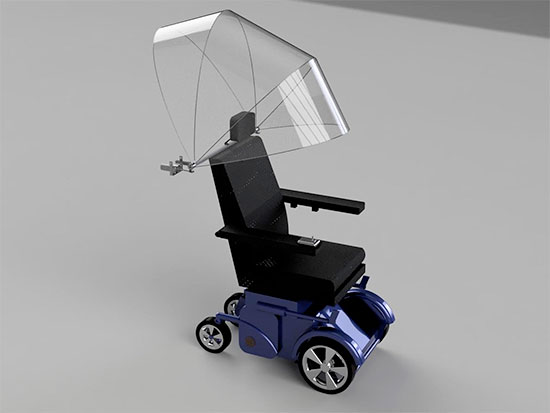 A new automatic umbrella attachment for mechanical wheelchairs offers protection for the head, chest, knees and, most importantly, the electronic controls when raining. Power wheelchair users may see a solution to rainy days with a new automatic umbrella attachment engineered by University of Alabama at Birmingham students. The UAB School of Engineering team is one of six internationally selected to present their designs at the eighth annual World Congress of Biomechanics in Dublin, Ireland, in July.
A new automatic umbrella attachment for mechanical wheelchairs offers protection for the head, chest, knees and, most importantly, the electronic controls when raining. Power wheelchair users may see a solution to rainy days with a new automatic umbrella attachment engineered by University of Alabama at Birmingham students. The UAB School of Engineering team is one of six internationally selected to present their designs at the eighth annual World Congress of Biomechanics in Dublin, Ireland, in July.
“Currently there are not many options to protect power wheelchair users from the weather,” said Jessica Pieczynski, a senior from Madison, Alabama, studying biomedical and mechanical engineering. “Our project supports clients who currently need someone to hold an umbrella for them when it rains. This device will allow power wheelchair users to be more independent, while still covering a majority of their body.”
The multiribbed canopy attaches to the headrest mount of the wheelchair. Attachment brackets are packaged separately based on various wheelchair models. The canopy is clear, which allows full visibility for the user. When the canopy is fully deployed, it offers protection for the head, chest, knees and, most importantly, the electronic controls. The folded canopy can be stored behind the user’s head when not deployed.
“Power wheelchair users often have limited use of their upper extremities,” said Phil Klebine, a UAB employee in the Department of Physical Medicine and Rehabilitation and a power wheelchair user who provided inspiration for the project. “This can make it very difficult to carry a traditional umbrella. This young, talented engineering team has designed a reasonable solution for power wheelchair users to stay dry on rainy days. That’s a big deal for me because I do a lot of outdoor traveling in my chair.”
| “Our project supports clients who currently need someone to hold an umbrella for them when it rains. This device will allow power wheelchair users to be more independent, while still covering a majority of their body.” |
The range for degree of rotation for the umbrella will be approximately 150-170 degrees. The inner rib will float for easier rotation purposes. It will provide structure and shape to the canopy. Two vertical bars extend down from the attachment bar to rest on the back of the chair to minimize torque from the wind, weather and the movement of the chair at top speeds. The device will be operated using a three-option switch for deploy, retract and off.
The device will be attachable and detachable based on the requirements of the user. Users will have the device attached when they need protection from adverse weather conditions such as rain, snow and wind. The ribbed design allows for removal and compact storage, ideal for when protection is not needed. The attachment of the device to the headrest frame and being model-specific is its novelty.
“Our goal is to present this need to the conference and hopefully provide power wheelchair users a device to help protect them from inclement weather,” Pieczynski said.
The group placed in the top six undergraduate biomedical senior design projects and will present at the conference in July. Group members include Pieczynski; Gerardo Hernandez, a recent biomedical engineering graduate from Pelham, Alabama; Tess Vessels, a recent biomedical engineering graduate from Athens, Alabama; and Seth Patterson, a recent biomedical engineering graduate from Panama City, Florida.